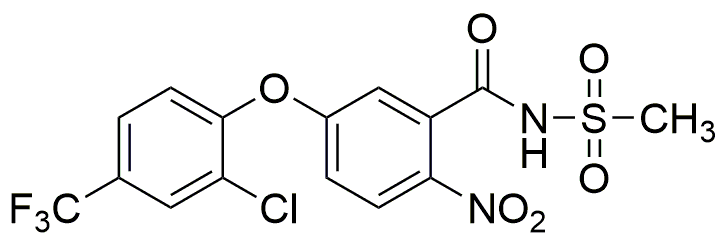Fomesafen is widely utilized in research focused on:
- Agricultural Herbicide: Primarily used in agriculture, it effectively controls a variety of broadleaf weeds in crops like soybeans and cotton, helping farmers improve yield and reduce competition for nutrients.
- Environmental Studies: Researchers study its environmental impact, assessing how it behaves in soil and water, which aids in developing sustainable farming practices and understanding herbicide resistance.
- Formulation Development: In the agrochemical industry, it serves as a key ingredient in herbicide formulations, allowing manufacturers to create products that are both effective and safe for crops.
- Integrated Pest Management (IPM): Used in IPM strategies, it helps in managing weed populations while minimizing the use of other chemicals, promoting a more eco-friendly approach to pest control.
- Research on Resistance Mechanisms: It is studied in laboratories to understand the mechanisms of weed resistance, providing insights that can lead to the development of new herbicides and management strategies.
Información general
Propiedades
Seguridad y normativas
Aplicaciones
Fomesafen is widely utilized in research focused on:
- Agricultural Herbicide: Primarily used in agriculture, it effectively controls a variety of broadleaf weeds in crops like soybeans and cotton, helping farmers improve yield and reduce competition for nutrients.
- Environmental Studies: Researchers study its environmental impact, assessing how it behaves in soil and water, which aids in developing sustainable farming practices and understanding herbicide resistance.
- Formulation Development: In the agrochemical industry, it serves as a key ingredient in herbicide formulations, allowing manufacturers to create products that are both effective and safe for crops.
- Integrated Pest Management (IPM): Used in IPM strategies, it helps in managing weed populations while minimizing the use of other chemicals, promoting a more eco-friendly approach to pest control.
- Research on Resistance Mechanisms: It is studied in laboratories to understand the mechanisms of weed resistance, providing insights that can lead to the development of new herbicides and management strategies.
Documentos
Hojas de datos de seguridad (HDS)
La SDS proporciona información de seguridad completa sobre la manipulación, el almacenamiento y la eliminación del producto.
Especificación del producto (PS)
La PS proporciona un desglose completo de las propiedades del producto, incluida la composición química, el estado físico, la pureza y los requisitos de almacenamiento. También detalla los rangos de calidad aceptables y las aplicaciones previstas del producto.
Certificados de análisis (COA)
Busque certificados de análisis (COA) ingresando el número de lote del producto. Los números de lote y de partida se pueden encontrar en la etiqueta de un producto después de las palabras "Lote" o "Lote".
Número de catálogo
Número de lote/lote
Certificados de origen (COO)
Este certificado de origen confirma el país en el que se fabricó el producto y también detalla los materiales y componentes utilizados en él y si se deriva de fuentes naturales, sintéticas u otras fuentes específicas. Este certificado puede ser necesario para cumplir con las normativas aduaneras, comerciales y regulatorias.
Número de catálogo
Número de lote/lote
Hojas de datos de seguridad (HDS)
La SDS proporciona información de seguridad completa sobre la manipulación, el almacenamiento y la eliminación del producto.
DownloadEspecificación del producto (PS)
La PS proporciona un desglose completo de las propiedades del producto, incluida la composición química, el estado físico, la pureza y los requisitos de almacenamiento. También detalla los rangos de calidad aceptables y las aplicaciones previstas del producto.
DownloadCertificados de análisis (COA)
Busque certificados de análisis (COA) ingresando el número de lote del producto. Los números de lote y de partida se pueden encontrar en la etiqueta de un producto después de las palabras "Lote" o "Lote".
Número de catálogo
Número de lote/lote
Certificados de origen (COO)
Este certificado de origen confirma el país en el que se fabricó el producto y también detalla los materiales y componentes utilizados en él y si se deriva de fuentes naturales, sintéticas u otras fuentes específicas. Este certificado puede ser necesario para cumplir con las normativas aduaneras, comerciales y regulatorias.

